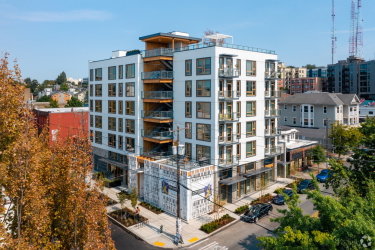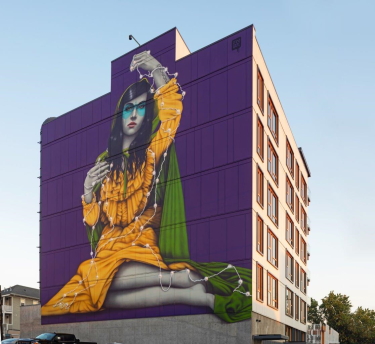|
Subscribe / Renew |
|
|
Contact Us |
|
| ► Subscribe to our Free Weekly Newsletter | |
| home | Welcome, sign in or click here to subscribe. | login |
Construction
| |

May 27, 2021
Massive mural is a nod to Passive House design for East Pike apartment building
Special to the Journal
The 75-foot mural on the side of the Solis, a new apartment development in the Pike-Pine corridor, tells onlookers that they have arrived at the “center of the universe.”
The mural, by artist FinDAC, symbolizes the sun and its role in the Passive House-designed development.
“The girl in our mural represents the sun and is holding a string of lights that represent the stars in the sky,” said Danya Feltzin, vice president of asset management with SolTerra, which developed Solis. “The tattoos on her wrist represent the planets in our solar system, so the whole concept is built around the idea that she is the center of the universe.”
Located at 1300 E. Pike St., the 45-unit development, designed by Weber Thompson, reaches for the sky when it comes to sustainable design. “Solis is one of the most energy efficient buildings on the West Coast and is a certified Passive House,” Feltzin said.
The building was completed last summer and the general contractor was Cascade Built. Feltzin said the structure has a goal of achieving a 70% reduction in energy use in its heating and cooling needs.
“Unlike many alternative sustainable certifications, Passive House certification is not achieved solely through design,” he said. “Passive House buildings must meet strict standards through testing upon completion of the building. This forced us to overshoot the standards in design and build. Furthermore, the energy modeling is complex and minor changes, such as how balconies are attached or the material of the shades within the units, prompts a new calculation.”
Complete with a rooftop garden and dog run, Solis contributes to the ongoing redefinition of one of Seattle's hippest neighborhoods — a transformation that dates back to the 1960s, when the corridor and Capitol Hill found new life as Bohemian-culture hangouts. Once known as Auto Row, the Pike-Pine corridor has seen multifamily growth expand in the last 20 years. The Solis site formerly was home to the Fran's Chocolates building.
Feltzin said the Passive House-designed Solis aligns with the values of SolTerra.
“High energy efficiency is one of our core beliefs, due to the long-term environmental impact and Solis is our most energy efficient building to date,” he said. “Solis also does an amazing job of blending indoor and outdoor spaces throughout, making it feel like an oasis within the urban environment. This is another core tenet of SolTerra's, since we believe that maintaining a connection to nature on a daily basis improves people's health and well-being.”
SolTerra chose Cascade Built because it had worked with the contractor on prior sustainable development projects.
“There are several certified Passive House GCs in Washington,” Feltzin said. “We had worked with Cascade Built prior, so this was an easy choice. There was some learning on the job with materials and techniques that none of the team had used prior, but fortunately we had a smart and experienced team on-site and all were quite successful.”
SolTerra has completed and is planning more sustainable and Passive House projects in Seattle and Portland. Feltzin said design review in Portland is “a little more stringent because there is a single board for the whole city that is fairly consistent in requiring higher quality materials, design criteria, etc. In Seattle, there are separate neighborhood boards that review projects and make recommendations to the city reviewer that is assigned to a project.”
SolTerra originally designed Solis as a condominium project, but decided to make it an apartment to provide better long-term value for investors.
Solis and its sustainable design strike a chord with residents who value living sustainably, according to Feltzin.
“Our passion for sustainable projects aligns with residents' own personal mantra and this naturally creates more harmonious communities,” he said. “So, our holistic approach to development organically creates healthier communities that are more enjoyable for our residents. Our projects simply curate a community with common values.”
Previous columns:
- Buttigieg reinstates local hiring program for public works construction projects, 05-20-2021
- King County creates more opportunities for MWBE design and construction contractors, 05-13-2021
- Will 3D printing solve the housing shortage?, 05-06-2021
- It's a wrap: County turns old Harbor Island flour mill into Hollywood-style sound stage, 04-29-2021
- 2 years after devastating fire, Notre Dame gets ready for actual restoration phase, 04-22-2021
- Fort Worden transformed to ‘make art, not war', 04-15-2021
- $550M Geffen Hall rebuild opening in fall 2022, about 18 months early, 04-08-2021
- Transferring the family business to the next generation may get more expensive, 04-01-2021




